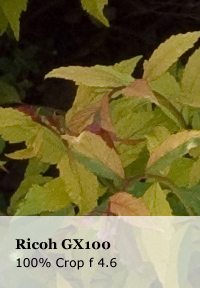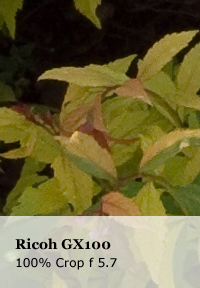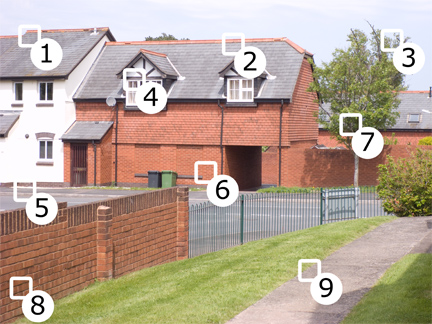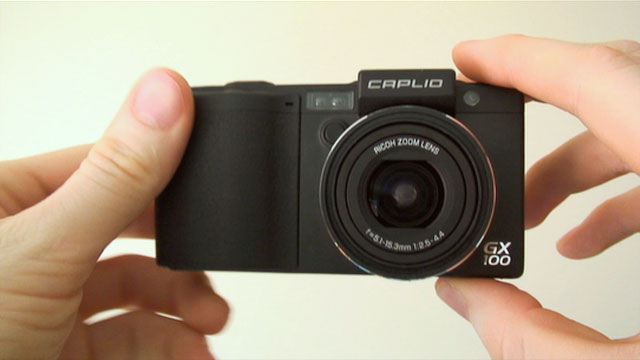Ricoh Caplio GX100 review with RAW (DNG) sample images and video review
On this page:
- Differentiating Features
- Other GX100 Main Features
- Ricoh GX100 vs. other full manual compacts with raw support
- Sample Images and Files
- Conclusion
Differentiating Features
We'll start by looking at the main features that set the camera apart its competition.
Small size
When you hold this camera for the first time you will probably be surprised by it's size; especially if you're comparing it to the Canon G9 which seems to be it's main competitor. It's also much lighter than the G9. Play the video review to get a better sense of scale.
AAA batteries or proprietary battery
This is a very rare feature indeed and one that I find very useful. Considering it's size it is quite remarkable that Ricoh spent the time devising a battery housing that could not only accommodate it's 1150mAh proprietary battery but also 2 AAA batteries (not included with the camera) which are available in very high capacities
these days. To see this in action play the video review.
Wide Angle zoom lens
The appealing 24mm wide angle lens is another feature that sets this camera aside from it's competition. Although the compromise is the loss of a more powerful zoom, such as on the Canon G9. The Ricoh GX100 has a 3x optical zoom which takes it to 72mm at the telephoto end. The 24-72mm figures are 35mm equivalents, the actual lengths are 5.1-15.3mm.
It's not a particularly fast lens at the telephoto end with the widest aperture being f4.4; according to this diffraction limitation calculator thats only just fast enough for diffraction limitation to not be a problem. Of course its very subjective as to when diffraction limitation becomes noticeable.
Non-proprietary DNG raw format and mini-USB connection
Again Ricoh's support for non-proprietary formats will please many, myself included. Instead of creating yet another raw format, Ricoh wisely decided to use the DNG (Digital Negative) format which is widely supported. Incidentally the Richo GX100 uses a standard peripheral type USB connector so you won't need to remember to bring it's cable with you everywhere you go as you can use any normal mini-USB cable to connect to a computer. Unlike some Fuji cameras the Ricoh mounts as a mass storage device so there are no compatibility issues with computers either.
Other GX100 main features
We'll look at the camera's main features that are largely typical of it's competition.
10MP sensor, compared with the Canon G9's larger, 12.1MP sensor
The Ricoh GX100 sensor size is 1/1.75-inch which is slightly smaller than the Canon G9's 1/1.7-inch 12MP sensor. With the help of mathematic formulas beyond my grasp it's possible to calculate the pixel area of the two for comparison. Luckily that website has already calculated the pixel area for sensors of this size and megapixel count (Casio Exilim Z1080) as well as the G9. So the Ricoh GX100 has a pixel area of 4.36 and the Canon G9 has a pixel area of 3.8 - this means the Ricoh has an advantage in terms of noise and diffraction limitation, even though it has lower overall resolution. Of course the Canon's higher resolution means an image can be printed at a higher DPI thus reducing the impact of both noise and diffraction limitation, so there's probably little real world difference. Here are some excellent articles on diffraction limitation and sensor size.
Vibration (hand shake) correction
The Ricoh uses a CCD shift method of camera shake correction which seems to work well. If the camera is in an automatic or aperture priority mode it will in fact allow itself to expose brighter if the anti-shake function is turned on. In a test in a darkish room on aperture priority set to f2.9 the camera selected 1/5th second shutter speed without anti-shake on and 1/3rd second with it turned on.
1cm Macro mode
The Ricoh GX100 macro mode allows you to focus as close as 1cm from the lens when zoomed out, and still as close as 4cm when fully zoomed in. Thats very flexible but not uncommon among decent cameras.
Manual functions
Quite a rarity on this size of camera. It seems most manufacturers want to encourage sales of their DSLRS by removing manual control from their compacts. I don't think I'm alone in the desire for a compact carry-anywhere camera with full manual control and RAW output. As this article shows, the choice is somewhat limited. Non-the-less, the GX100 does have full manual focus, manual shutter speed and aperture control and raw support.
The interface is very customizable too which is great for setting up the camera to work for your personal style. More on this in the video review.
Customizable interface
The Ricoh GX100 has a very customizable interface. Of course this means it takes a little while to get it set up just how you like but it's worth it. The main control is the 'Adj.' (Adjustment) button on the back of the camera. This is a rocker/push button which is used to adjust he shutter speed when in manual mode by flicking it right or left. However, if you push it in you will be presented by a shortcut menu which contains up to 4 function which you specify. The available shortcuts are:
- Exposure Compensation
- White Balance
- ISO
- Quality
- Focus
- Image Settings
- AE Meter
- Continuous Mode
- Auto Bracket
- With Sound
Ricoh GX100 vs. other full manual compacts with raw support
The list of cameras presented on the 'Serious Compacts' article mentioned above is a good place to start when comparing the GX100 with similar cameras. Heres a little list of comparisons as food for thought.
- Ricoh GX100 (Buy UK
Buy USA
):
Widest lens in the bunch. 3x optical zoom (24mm-72mm), Small and quite light, good use of non-proprietary standards. Another few reviews. - Sigma DP1 (Buy UK
Buy USA
):
Very specifically spec'd camera with fixed 28mm lens. 4.64 MP (3 photosites per pixel though). APS-C size sensor. Pricey. (But, yes I want one) Sigma DP1 review. Another Sigma DP1 review. - Ricoh GRDII (Buy UK
Buy USA
):
Lightest of the bunch, but fixed lens at 28mm (no optical zoom). Ricoh GRDII review. - Canon G9 (Buy UK
Buy USA
):
Feature packed with 6x optical zoom (35mm-210mm), but quite large and heaviest of the bunch. Canon G9 Review. Another Canon G9 review. - Panasonic FZ8 (Buy UK
):
'Superzoom' type, big lens but with 12x optical zoom (36mm-432mm). Panasonic FZ8 review. - Panasonic LX2 (Buy UK
Buy USA
):
16:9 CCD and screen. 4x optical zoom (28mm-112mm). Few years old now. Panasonic LX2 review.
Of course I can't compare the image quality here as I haven't used all the cameras so this comparison is incomplete without such data. However the review links should help you make a decision.
Sample Images and files
The image quality of the Ricoh GX100 is generally very good but there a few things you need to be doing to get the best out it. The noise gets bad over ISO 100 but thats to be expected with this number of megapixels on such a small chip. With small sensors you either choose excellent resolution when using low ISOs or low megapixel/resolution cameras which can shoot with a wider range of ISOs.
The other issue with small sensors is diffraction limitation (see main features section above). This seems to affect the image quality if you use an aperture smaller (physically, i.e f6) than f3.2 but in practice you should be ok using f4.4.
This may seem like a hefty set of trade offs but thats the name of the game with small sensors and many megapixels. You either appreciate the limitations and enjoy the portability or get a digital SLR.
Aperture / Diffraction test
The following 100% crops show how diffraction affects the images as the aperture decreases. Each column contains exactly the same images. I duplicated them so that you can compare different results side by side. The images start to get softer after about f4.1 and are very soft indeed at f8.1 and f9.1.
These pictures were taken in aperture priority mode so the camera decided on a shutter speed. Interestingly f2.5 is over-exposed compared to the rest. I have tried to select a section of the image that isn't affected by the exposure difference too much as obviously this affects the clarity test.
These images have been sharpened manually in Adobe Lightroom
by identical amounts, just to give an accurate impression of the attainable clarity. As the sharpening is consistent throughout these samples it doesn't affect the test.
























Below are a few of the original raw DNG files and Adobe Lightroom
processed jpgs that were taken for the above tests. Right click on the links and click 'Save target As..' or similar to avoid the browser trying to display the files. Remember all these files are of the same shot, just taken with different apertures, so it's unlikely you'll need to download all of the files.
Raw DNG file (f2.9) or Lightroom processed JPG (f2.9)
Raw DNG file (f3.2) or Lightroom processed JPG (f3.2)
Raw DNG file (f4.1) or Lightroom processed JPG (f4.1)
Raw DNG file (f6.5) or Lightroom processed JPG (f6.5)
Raw DNG file (f9.1) or Lightroom processed JPG (f9.1)
Wide angle lens test
Below are 9 100% crops taken from various positions in the image. The shot was taken at f2.9 so shouldn't be suffering from any diffraction limitation. Analysis of the samples follows the images. You can download the original raw DNG image used for this test or the Lighroom processed jpg.


You can see top left and bottom left corners do suffer from blurring. But, considering this is taken on a zoom lens that goes as wide as 24mm I think it's acceptable. Sample 4 is still off-center and near the top left corner and the image is looking pretty clear at this point. There is slight softening at position 2 but not as pronounced as in position 1. Position 3 shows some chromatic abortions which I didn't try to correct but can usually be removed quite easily in Adobe Lightroom
. Sample 6, taken from the center is the best, as expected. The bottom left corner is again suffering a bit too.
Full zoom lens test
Below are 9 100% crops taken from various positions in the image. As the speed of the lens decreases when zoomed in the aperture had to be set at f4.4 which might be starting to show diffraction limitation. Analysis of the samples follows the images. You can download the original raw DNG image used for this test or the Lighroom processed jpg.


There is less blurring in the corners of this image. Compare position 1 with the similarly positioned sample in the wide angle test. Although possibly the overall sharpness is slightly less. This could be down to diffraction limitation though. There is significant blurring at position 3. However, it was a windy day so this could be due to the movement of the leaves.
Conclusion and where to buy
To conclude a review of the Ricoh GX100 we need to make sure we're discussing it in comparison with other cameras in it's class and appreciate the inherent limitations of this type of camera.
This means we need to appreciate that the ISO is going to cause a lot of noise if set to over 100 and diffraction limitation will come into play limiting the use of small apertures. However, it's a double edged sword as the reason a photographer might use a small aperture is to get a greater depth of field. With compact cameras with small sensors, the depth of field is naturally greater than a 35mm or digital SLR camera. So, the reason the diffraction limitation is in effect is also the solution to the problem.
Comparing the GX100 with it's competition (listed in the Ricoh vs others section above) is relatively easy they all offer very distinctive advantages/disadvantages. It should be clear to you by now which one is for you. For me I chose the Ricoh because I wanted the wide angle zoom lens and portability, but still with a 10MP image. Those requirements alone mean this camera is about my only choice. I'm happy to accept the diffraction limitation and high ISO noise issues as a trade-off for these virtues and am very happy with the camera. It's small size and minimal weight mean I can have it on me at all times which is something I have always wanted to do.
If, like me, you feel this camera is the one for you, you can usually find good deals at Amazon.co.uk
or Amazon.com if you're in the USA
.
8 May 08
0 COMMENTS


There are no comments yet. Be the first to add a comment by using the form below.